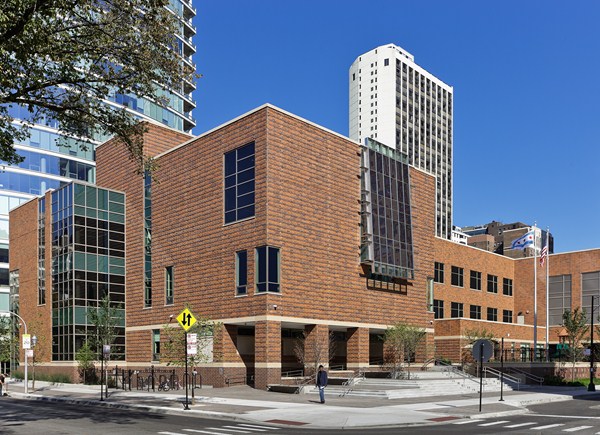The Brick Industry Association (BIA) has opened entry submissions for its 2013 Brick In Architecture Awards—with a new Renovation/Restoration category and new category divisions this year. BIA’s annual awards honor architectural excellence and sustainable design nationwide that incorporates clay brick products as the predominant exterior building or paving material. Entries are due by April 30. To enter and for details, go to: http://www.gobrick.com/EventsEducation/BrickInArchitectureAwards/tabid/7661/Default.aspx
The 2013 awards competition will be conducted entirely online. Architectural and design firms from around the country can enter their best material to be judged by a jury of their peers.
“As a versatile building material made in America made from abundant natural resources, there is no substitute for genuine clay brick,” said BIA President and CEO Gregg Borchelt, P.E. “In addition to its unmatched durability and many benefits from its physical properties, brick offers aesthetic flexibility to match the architect’s imagination and desires, and is a main element in sustainable design,” he said.
As the largest and most prestigious juried competition of its kind, entries can be submitted in one or more of the below categories:
- Commercial (Under $10 Million) – New
- Commercial (Over $10 Million) – New
- Education – K-12
- Education – Colleges & Universities (Higher Education)* – New
- Health Care Facilities
- Municipal / Government
- Houses of Worship
- Residential – Single Family
- Residential – Multi-Family
- Renovation (Additions)** / Restoration (Restoring) – New
- Paving & Landscape Projects
*Includes residence halls & academic/administrative buildings
**Additions must use at least 50 percent new clay brick products on the building. Restoration construction must include at least 50% clay brick products, which can either be new or salvaged.
For complete information on eligibility, submission requirements, and judging, visit
http://www.gobrick.com/EventsEducation/BrickInArchitectureAwards/tabid/7661/Default.aspx
Founded in 1934, the Brick Industry Association (BIA) is the nationally recognized authority on clay brick construction representing the nation’s distributors and manufacturers of clay brick and suppliers of related products. Web site: www.gobrick.com /703-620-0010.
Related Stories
| Nov 11, 2013
4 trends driving the recovering commercial construction sector
Jones Lang LaSalle research reveals a four-point “new look” for the post-recession construction industry.
| Nov 8, 2013
Oversized healthcare: How did we get here and how do we right-size?
Healthcare facilities, especially our nation's hospitals, have steadily become larger over the past couple of decades. The growth has occurred despite stabilization, and in some markets, a decline in inpatient utilization.
| Nov 8, 2013
Can Big Data help building owners slash op-ex budgets?
Real estate services giant Jones Lang LaSalle set out to answer these questions when it partnered with Pacific Controls to develop IntelliCommand, a 24/7 real-time remote monitoring and control service for its commercial real estate owner clients.
| Nov 8, 2013
S+T buildings embrace 'no excuses' approach to green labs
Some science-design experts once believed high levels of sustainability would be possible only for low-intensity labs in temperate zones. But recent projects prove otherwise.
| Nov 8, 2013
Net-zero bellwether demonstrates extreme green, multifamily style
The 10-unit zHome in Issaquah Highlands, Wash., is the nation’s first net-zero multifamily project, as certified this year by the International Living Future Institute.
| Nov 8, 2013
Walkable solar pavement debuts at George Washington University
George Washington University worked with supplier Onyx Solar to design and install 100 sf of walkable solar pavement at its Virginia Science and Technology Campus in Ashburn, Va.
| Nov 6, 2013
PECI tests New Buildings Institute’s plug load energy use metrics at HQ
Earlier this year, PECI used the NBI metrics to assess plug load energy use at PECI headquarters in downtown Portland, Ore. The study, which informed an energy-saving campaign, resulted in an 18 percent kWh reduction of PECI’s plug load.
| Nov 5, 2013
Net-zero movement gaining traction in U.S. schools market
As more net-zero energy schools come online, school officials are asking: Is NZE a more logical approach for school districts than holistic green buildings?
| Nov 5, 2013
New IECC provision tightens historic building exemption
The International Energy Conservation Code has been revised to eliminate what has been seen as a blanket exemption for historic buildings.
| Nov 5, 2013
Living Building Challenge clarifies net-zero definitions and standards
The Living Building Challenge has released the Net Zero Energy Building Certification to provide clearer definitions regarding what net zero really means and how it is to be achieved.

















